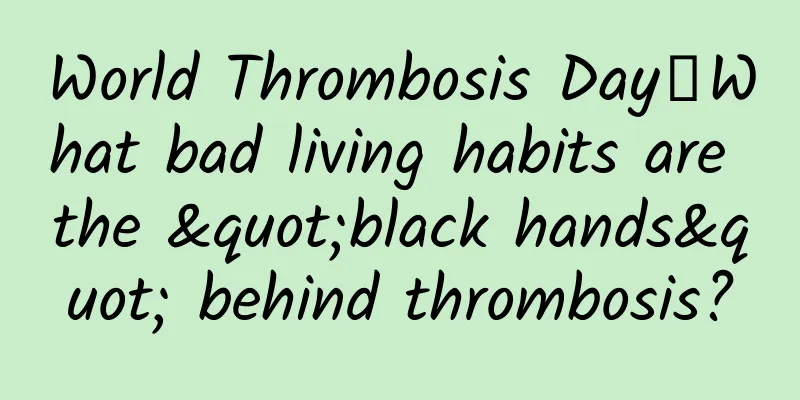World Thrombosis Day丨What bad living habits are the "black hands" behind thrombosis?

|
Author: Liu Xinming, attending physician, Beijing Chaoyang Hospital, Capital Medical University Reviewer: Chi Hongjie, Chief Physician, Beijing Chaoyang Hospital, Capital Medical University Thrombosis, this silent killer that seems far away but actually lurks in our daily lives, often poses a threat to our health inadvertently. It is not only common in the elderly, but with the development of society, more and more young people are also beginning to be threatened by thrombosis; thrombosis is like a time bomb hidden in our body, once it explodes, the consequences are disastrous. However, the formation of thrombosis is not without traces, and many bad living habits are the "black hands" behind it. Next, this article reveals which habits are likely to cause thrombosis, helping you start by changing your living habits and effectively prevent the formation of thrombosis. Figure 1 Copyright image, no permission to reprint 1. Bad eating habits - a hotbed for thickening blood Food is the first necessity of the people. As the saying goes, food is the essence of human nature. The food we think is "delicious" is often a mixture of high sugar and high salt. Such eating habits not only easily lead to overweight and obesity, affecting the growth and development of adolescents, but also may cause chronic diseases such as hypertension, diabetes, and coronary heart disease. Blood clots will also be quietly generated in the "hotbed" of high oil and high sugar. Mr. Yang is a taxi driver. He usually likes to eat greasy and high-salt food. He also particularly likes animal offal. After work late at night, he likes to go to the barbecue stall to eat some small skewers. However, late one night, Mr. Yang suddenly felt chest pain accompanied by shoulder and back pain, and a tightness in the throat. After a doctor's examination, he was diagnosed with acute myocardial infarction-a huge blood clot formed in the coronary artery. Fortunately, after interventional treatment, Mr. Yang was able to turn danger into safety. The reason is that it is because of his bad eating habits that his blood lipids and blood pressure are too high, and he also suffers from hyperuricemia. These factors work together and eventually cause acute myocardial infarction. The accelerated pace of modern life has led more and more young people to rely on takeout for their three meals a day. These foods are usually stored in transparent or white plastic packaging. Although convenient and fast, they may hide health risks. In recent years, researchers have found microplastics and dye particles in human blood, feces, and even placenta. In addition, a research team collected 24 samples of blood clots in the human aorta for analysis and found that the samples contained 87 types of particles. This makes us speculate that the formation of blood clots may be related to the microplastics in vitro entering the blood and attracting the aggregation of platelets and other coagulation substances, thus forming blood clots with microplastics as the core. Although there is no large-scale study to confirm the direct link between microplastics and blood clots, this finding still reminds us to minimize the food stored in plastic products, which may reduce the intake of microplastics, thereby reducing the risk of blood clots and reducing the incidence of cardiovascular diseases. 2. Long-term sitting - an accelerator of lower extremity venous thrombosis Sitting still for a long time will reduce leg activities, reduce muscle contraction movements, and slow blood flow, which will eventually lead to blood accumulation in the veins of the lower limbs and form lower limb venous thrombosis. Especially the elderly who have been bedridden for a long time or patients with disability after a stroke, as well as pregnant women in the late pregnancy are more likely to suffer from lower limb venous thrombosis. In addition, more and more white-collar workers and computer programmers often lack walking and leg exercises due to the nature of their work. If they are also accompanied by factors such as insufficient drinking water and increased sweating that lead to blood concentration, it is easier to form venous thrombosis. Venous thrombosis in the leg blood vessels can cause swelling and pain in the affected limbs, and even form ulcers on the skin surface that are difficult to heal. But these are just the "tip of the iceberg" of the hazards of lower limb venous thrombosis. There is a risk of thrombosis in the veins of the lower extremities falling off. Once the thrombus falls off, it will flow back to the pulmonary artery with the venous blood, causing a fatal disease - pulmonary embolism, which is a "killer" that ranks among the top three in the "Sudden Cardiac Death Ranking". It is no exaggeration to say that if you sit still for 4 hours, you will be at risk of developing venous thrombosis in the lower extremities. In order to prevent venous thrombosis, you should move your lower extremities frequently. Even if you cannot walk, you can do simple movements such as curling your feet and standing on tiptoes. At the same time, it is also very important to drink enough water. For people with a history of varicose veins, wearing elastic stockings can help increase venous return, thereby reducing the risk of thrombosis. 3. Long-term alcoholism and excessive coffee consumption are catalysts for atrial thrombosis Long-term alcohol abuse not only increases the risk of coronary heart disease, but may also cause alcoholic cardiomyopathy and gradually progress to chronic heart failure. A large number of studies have shown that long-term alcohol abuse is the main cause of atrial fibrillation. Atrial fibrillation, also known as atrial fibrillation, is a common arrhythmia characterized by the heartbeat rhythm is no longer regular and powerful, but becomes chaotic, like a band without a conductor, each acting on its own. This disordered beating not only affects the normal function of the heart, but may also cause a series of serious health problems, especially thrombosis and embolism. In patients with atrial fibrillation, blood stasis is the main cause of thrombosis. Especially in the left atrial appendage in the left atrium, due to its irregular structure and the presence of many "grooves and gullies", blood is more likely to accumulate and form thrombi here. Once these thrombi fall off, they will flow with the blood to all parts of the body. Among them, the most dangerous is that the thrombi enter the brain, causing cerebral artery embolism, which is what we usually call cerebral infarction. The risk of stroke in patients with atrial fibrillation is 5 to 7 times that of patients without atrial fibrillation. Cerebral infarction often has no signs, and once it occurs, it has a serious impact on individuals, families and society. Patients may experience symptoms such as slurred speech, limb weakness, hemiplegia, and unconsciousness, which may be life-threatening in severe cases. An interesting piece of knowledge: moderate coffee consumption may help reduce the occurrence of atrial fibrillation, but excessive intake may increase the risk of atrial fibrillation. For young people, staying up late and avoiding excessive coffee consumption are also the main measures to prevent atrial fibrillation. Figure 2 Copyright image, no permission to reprint 4. Excessive exercise: a roadblock to blood circulation Some friends may have questions when they see this. Isn't exercise a good thing? It's too alarmist to say that exercise can cause blood clots. Then we should start with atrial fibrillation. The effect of exercise on atrial fibrillation is a double-edged sword. On the one hand, moderate exercise can enhance cardiopulmonary function and reduce the risk of atrial fibrillation. For example, aerobic exercises such as jogging, swimming, and Tai Chi can effectively improve heart function and reduce the onset of atrial fibrillation. But on the other hand, excessive exercise may also increase the risk of atrial fibrillation. Especially long-distance, high-intensity exercise, such as marathons, may put too much burden on the heart, thereby inducing atrial fibrillation. In addition, if water is not replenished in time during long-term high-intensity exercise, the human body will lose a lot of water, the blood viscosity will increase, the blood circulation will slow down, and even induce endothelial inflammatory response, causing the rupture of the original atherosclerotic plaques in the vascular wall, thereby inducing acute thrombosis and even acute myocardial infarction. It is crucial to prevent dehydration, especially in hot weather or after strenuous exercise, to ensure adequate water intake to maintain fluid balance in the body. Therefore, avoiding excessive exercise in hot environments is crucial to avoid thrombosis. 5. Develop good living habits and stay away from the threat of blood clots October 13, 2024 is the 11th World Thrombosis Day. The establishment of "Thrombosis Day" is not only to commemorate the great contributions made by German physician Professor Rudolf LK Virchow in the field of thrombosis, but also to remind the public to pay attention to thrombosis and raise awareness of thrombosis prevention. If we pay attention to cultivating good living habits, we can greatly reduce the risk of thrombosis. By maintaining moderate exercise, healthy eating habits, adequate sleep time, staying away from the temptation of tobacco and alcohol, regular physical examinations, and actively controlling blood lipids, blood pressure and blood sugar, we can effectively prevent the formation of thrombosis. Let us start from now, start from the little things, and escort our own health! |
<<: Round and short, the "Bouncing Pig" turns out not to be a pig?
>>: If I punch in on time when the leap second arrives, will it be shown as late for work?
Recommend
The success rate of fake fingerprints cracking mobile phones is as high as 65%? Apple responded that the probability is only one in 50,000
Most people think that the TouchID sensor on iPhon...
Popular Science in Central Plains丨@Grandpa and Grandma, all the questions you care about about the new coronavirus vaccination are here!
Dahe.com (Reporter Shen Hua) At present, the COVI...
After knowing this, I don't want to eat clam vermicelli casserole anymore
Review expert: Gu Ming Di Lian (He Lin) is a well...
A brief analysis of the principles of mobile rendering
Author| Shang Huaijun Rendering on a computer or ...
A man died after extracting 23 teeth at once! Can you only extract one tooth at a time?
When it comes to tooth extraction, everyone is fa...
Nature: A nearly perfect human blastocyst model was born, and women are expected to have reproductive rights
Reproduction has been one of the most important l...
From power generation to deep space exploration: Microalgae offer a sustainable future
Life originated in the ocean. In the ocean, the m...
The four basic ways to attract users: mining, support, output and retention
Background: It has been four years since Changba ...
2016 Christmas Advertising Video Collection 2: Warmth makes winter no longer cold!
The annual Christmas is coming soon in this cold ...
This bill has prevented self-driving car testing in New York City.
In New York City, self-driving cars have not been...
From the sudden popularity of faceu and same, let’s talk about how to make a fantastic “killer” APP!
" Faceu has already ranked first on the free...
Why is the Zhongyuan Festival called the "Ghost Festival" and how are the three yuan divided into upper, middle and lower yuan?
This article is about 4160 words Reading time: 11...
Amazing! This offshore wind turbine can withstand up to 17-level typhoon
At 13:37 on December 7, the world's first typ...
I really didn't expect that this would be easy to use when traveling.
During holidays, if you want to travel, visit sce...









